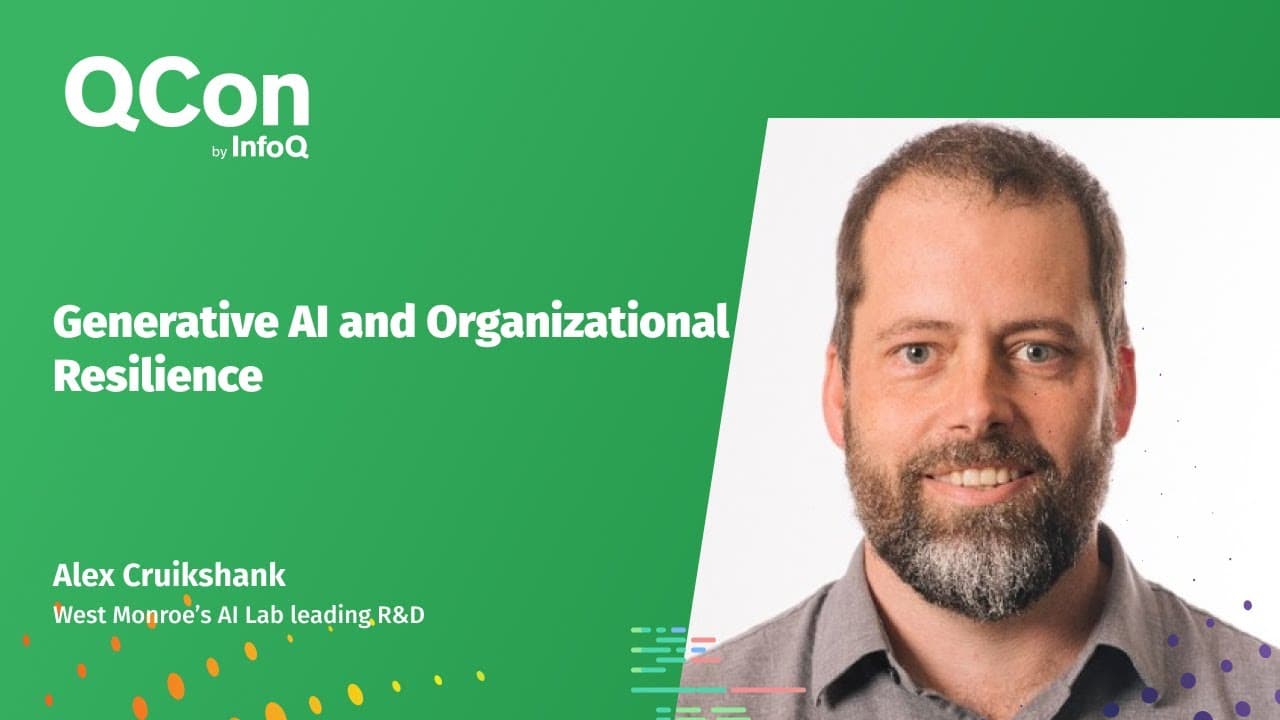Generative AI and Organizational Resilience
30 Aug 2024 (over 1 year ago)

Generative AI's Impact on Business and Productivity
- Computers are bad at interacting with humans and require specific instructions for every interaction. (43s)
- Conversational UIs like Alexa and Siri improved computer-human interaction but still rely heavily on pre-programmed responses. (1m43s)
- Generative AI allows computers to interact more naturally and independently, without pre-programmed responses. (2m38s)
- Generative AI has the potential to significantly impact business communication and processes, potentially leading to a 3.3% annual increase in global productivity. (3m50s)
- (6m39s) The transformation driven by generative AI will come from increased efficiency in business processes.
- (9m29s) A study by West Monroe using GitHub Copilot showed a 22% productivity gain for developers, indicating significant efficiency improvements.
Generative AI's Impact on the Workforce
- (6m56s) McKinsey's analysis shows that job automation will increase across all education levels, with generative AI significantly automating higher-skilled jobs.
- Companies should allow employees to use generative AI to automate their own jobs, as this technology is user-friendly and can improve productivity. (15m41s)
- Automation may cause job displacement, but it also presents opportunities for individuals to acquire new skills and pursue more fulfilling, AI-assisted roles. (30m40s)
- Some low-skill jobs, especially in customer service, are expensive, leading companies to explore AI replacements, although attempts have been unsuccessful due to the complexity of human interaction and the AI's inability to fully replicate it. (36m26s)
- Paralegals, often cited as being at risk of replacement by AI, perform a significant amount of their work (95%) doing tasks like making copies, which AI like ChatGPT cannot currently perform. (39m22s)
Generative AI's Impact Across Industries
- (8m15s) Generative AI will impact all departments within enterprises, enhancing communication and creating numerous small initiatives across the organization.
- (8m46s) Different industries, including manufacturing, retail, finance, insurance, and healthcare, face unique challenges and opportunities with generative AI.
Generative AI and User Experience
- (10m3s) Generative AI's ability to interact with people may reduce the need for extensive front-end development and UI work.
- (10m37s) While UX design automation is still developing, generative AI could soon assemble design components to create effective user experiences with minimal effort.
Adoption and Timeline of Generative AI
- (11m17s) The future of technology is already present but unevenly distributed, with existing technologies not yet widely adopted due to various factors.
- (12m9s) The timeline for the widespread adoption of generative AI is uncertain, but historical patterns from the growth of the internet, e-commerce, streaming, and social media provide some insights.
- Generative AI will likely cause significant transformations in industries in 2-3 years, with a potential for major shifts in 10 years. (14m20s)
Navigating the Challenges and Opportunities of Generative AI
- (6m18s) Economic resilience can be maintained despite financial crises, housing market dips, and rising gas prices, with generative AI potentially boosting productivity and benefiting the economy.
- While AI has the potential to disrupt industries and livelihoods, it is crucial to approach this change with a proactive mindset, embracing AI literacy and adapting to the evolving job market. (31m37s)
Promoting Responsible and Effective Use of Generative AI
- It is important to build AI literacy within companies to address concerns and promote the responsible and effective use of AI. (18m6s)
- People improve at using AI over time, learning which tasks are suitable for AI, how to write effective prompts, and how to prevent hallucinations. (18m43s)
- Sharing prompts, potentially through a platform like a wiki, content management system, or a shared spreadsheet, can save time, enhance AI literacy, and provide insights into business processes that employees are seeking to automate. (20m0s)
- When automating jobs, it is crucial to prioritize a product-focused approach: understand the actual tasks performed by workers, augment their capabilities with tools, observe the impact, and then focus on improving efficiency. (23m43s)
- To mitigate the risk of AI generating offensive content, it is advisable to avoid prompts that solicit humor and instead focus on clear, concise inquiries, leveraging intent filters and profanity filters to ensure appropriate responses. (35m25s)
Addressing the Uncanny Valley Effect in AI
- The Uncanny Valley is a concept from animation and robotics in which human-like characters become relatable as they appear more human, but as they come close to human likeness without being fully believable, they become unsettling. (24m24s)
- One way to avoid the Uncanny Valley effect with AI chatbots is to prevent them from using "I" as a pronoun and instead use "we" to represent the voice of the company rather than an individual. (26m5s)
Democratization of Generative AI
- Generative AI is approachable technology, and rather than technologists leading the way, individuals across various fields are exploring its applications, prompting programmers and product developers to catch up. (29m1s)